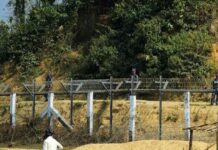
At 5 am, a thick dark fog hung about, as we heading south into the Sundarbans from the Chandpai forest station in southern Bangladesh.
A few kilometres on, visibility beyond the prow fell to near zero, forcing us to dock mid-river.
Voices rang out from somewhere in the thick blur: fishermen singing to signal their presence. Occasionally, a low dinghy would row quietly by, unseen until it was almost upon us. In the distance, a ship boomed its approach. Our boat master shook his head in concern. He revved up the engine and guided us into a khal, a channel.
The morning of Dec. 9, 2014 must have felt similar. The oil tanker Southern Star 7 was docked four kilometres from the confluence of the Sela and Passur rivers, near Mrigamari, in dense fog. It carried 350,000 liters of heavy, black furnace oil.
Shrouded in the fog, a cargo ship also plying the same channel rammed into the Southern Star 7—discharging copious quantities of oil as the tanker sank.

Fragile ecosystem
The Sela is part of the Sundarbans, the largest unbroken stand of mangrove forests in the world. A fragile ecosystem that has adapted itself to life on the brink of brine, these mangroves form the margin between the salt water of the Bay of Bengal and the freshwaters of three mighty South Asian rivers: the Ganges, the Brahmaputra, and the Meghna.
The Sundarbans, which literally translates as “beautiful forest,” straddles the border between India and Bangladesh along the eastern Indian state of West Bengal. India has 40% and Bangladesh has 60% of the mangroves. Both areas are designated wildlife sanctuaries and reserve forests.
This mangrove margin is home to some of the world’s most endangered creatures: the masked finfoot; the Irrawaddy, Gangetic, and four other kinds of dolphins; the Bengal tiger and the beautiful, endangered Sundari tree (Heritiera fomes). Almost a million forest people depend upon this ecosystem for their livelihood.
By definition and by law, heavy shipping traffic carrying hazardous cargo has no place in the Sundarbans. Yet in Bangladesh, tankers carrying “modified cargo”—oil, pesticides, fertilisers, insecticides, fly ash, cement, sand, and salt—travel through these channels every day.
On Dec. 9, the inevitable happened. Two ships collided and 230,000 liters of oil flowed into this corner of the Sundarbans.

Chasing the slick
Our boat, the Gol-Patta, reached the Sundarbans on Dec. 14, four days after the spill. Men, women, and children were knee deep in the mudflats and elbow deep in heavy fuel oil. They were scraping black, viscous goo from sedges, reeds, leaves, trunks and roots. Each painstaking handful of black pulp collected was smeared off along the rim of a cooking pot. Then, they turned back to the plants for more.
Children, mostly aged between 10 years and 16 years, were covered in black from toe to waist.

Khals— channels that snake through the mangroves—now flowed dark, dirty, and viscous. The forest stood ankle deep in low tide, in 3 metre-high black, tar socks. The high-tide line had become the oil-line.
The river below glistened with oil, too: graded by thickness from black to brown and then all colors of the rainbow.
Dark acrid stinging fumes spiraled from fires heating oil in the sleepy fishing village of Joymoni on the Sela river.

Save for the blackened fishermen and children, no one else was cleaning the spill. The slick sloshed forward in the ebbing tide. We followed it: four km past the spill site, eight km past the spill site, 12km past the spill site and eventually, 40km past.
The slick sloshed ahead of us, beside us, behind us. Films of oil of varying thicknesses floated in the main channel and pooled in the smaller khals. The tide went out by nightfall and came back in at dawn. The oil was no different.
Fishermen claimed that the slick was visible almost 80km down the river.
Dark truth
The plants and trees of mangrove forests are uniquely adapted to the salt-and-sweet water inter-tidal zone. They deal with submergence during high tide by sprouting aerial roots, snorkels that stay above the water to breathe. Those snorkels (called pneumatophores) were now smothered in black oil. The forest may well be choking, gasping for breath.
In Dhaka, capital of Bangladesh, newspapers screamed of dying animals. Activists on social media posted doctored images of oil-dripping dolphins and oil-swimming tigers. To counter the anger, the government spokespersons shot back officialese for ‘no harm came from the oil-spill and it is all under control.’
The dark truth lurked somewhere in between.
Animals caught in the water during the first few days of the spill were coated with oil, and may have died. On Dec. 14, we saw a blackened crocodile tentatively slipped into a brown slick 10km from the spill site.
But the worry was not so much of animals dying in the immediate aftermath, but of the oil staying in the water, on the mudflats, and smearing the trees.
The effects of the coated and residual oil will be seen over months in the forests of this ecosystem. It could manifest in hormonal changes and reproductive changes, over time, in animals exposed to the substance. How exactly this spill will affect the ecosystem can only be determined by a scientific longitudinal study which, at this point, no one has signed up to undertake.
A spill of this magnitude in an area this ecologically sensitive is a qualifiable, quantifiable disaster mandating emergency measures. Yet, clean-up operations have been slow and unscientific, and are focused only on recovering the oil from the banks in a buy-back scheme by the company, Padma Oil, that owned the barrels in the Southern Star 7.
Health risk
This is perhaps the biggest hazard: fishermen from the village (Joymoni) most affected by the spill are collecting the oil. Children, women, men, all scrape the goo by hand and collect floating smeared plant matter that they dump into their boats.


The boats are towed back to the village “depot” by the forest department, which is coordinating the effort (with local NGOs). Here, the plant matter is boiled and heated to loosen the oil. This is collected in barrels, and trucked back to Padma Oil.
The fishermen are doing all the collection and boiling without any protective gear. They are smeared in oil by day on the river, and engulfed in its fumes when they get home. These oils contain chemicals that are toxic. It can have dire digestive, pulmonary, and dermatological effects and, if the exposure extends over time, also neurotoxic effects.
A dozen days after the spill, the children of Joymoni have begun to fall sick.
But right now, it is all about recovering and selling back the oil.
This post first appeared on Ficus Media.









